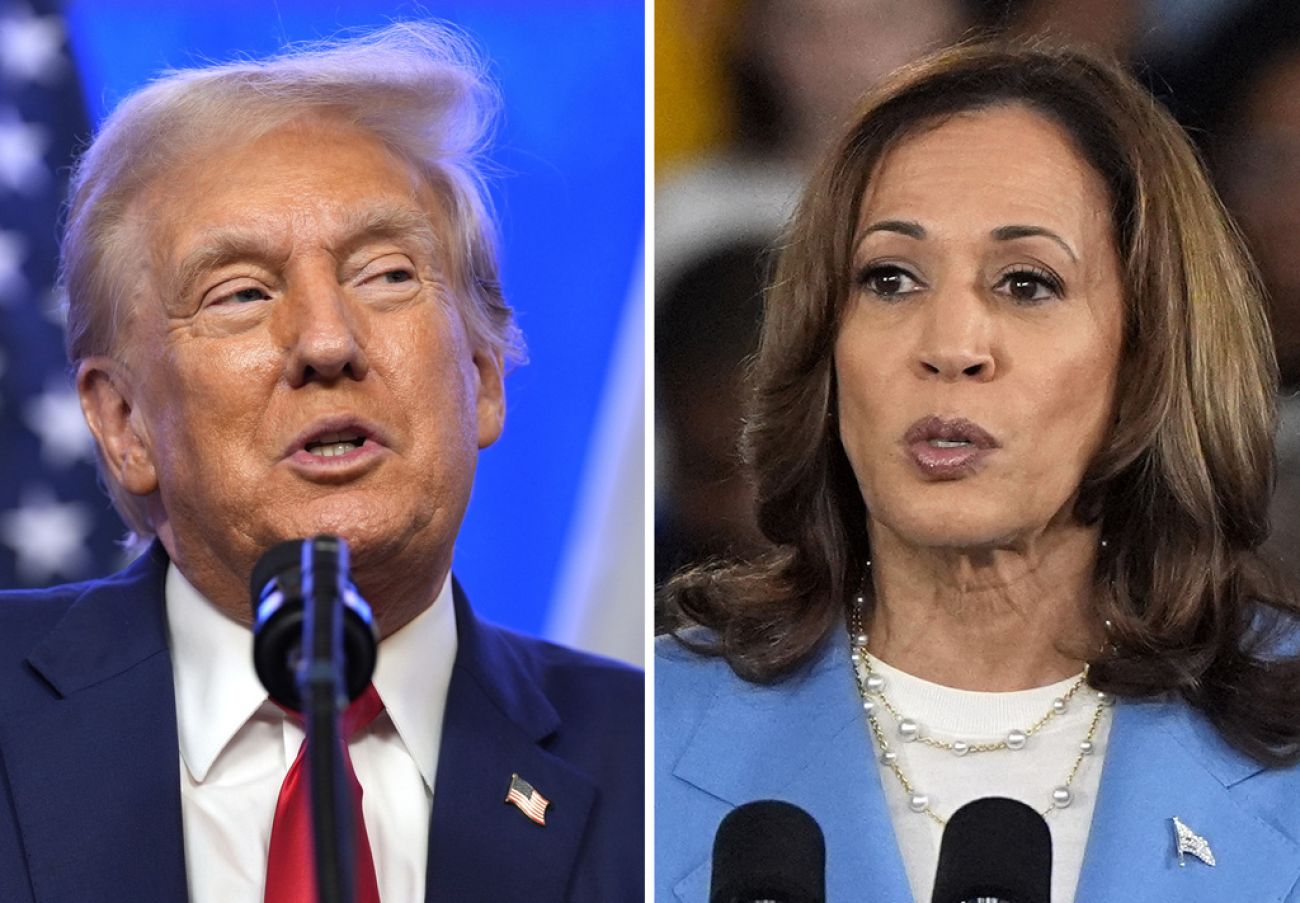Raise taxes on the rich or cut them? Harris, Trump differ on economic plans

- Donald Trump pitches more tax cuts if elected to second term
- Kamala Harris wants to raise taxes on wealthy and corporations to pay for tax breaks for parents
- Plans by both candidates would raise federal deficit
WASHINGTON — Donald Trump is betting that Americans crave trillions of dollars in tax cuts — and that growth will be so fantastic that it's not worth worrying about budget deficits.
In short, he's hoping that most economic analyses of his ideas are dead wrong.
Vice President Kamala Harris believes that big corporations and the ultra-wealthy should pay more in taxes — and wants to use those revenues to help spur the construction of 3 million homes and offer tax breaks for parents.
She's hoping to deliver on the types of policies that President Joe Biden has been unable to secure in a lasting way.
The two presidential nominees are using the week before their debate to sharpen their economic messages about who could do more for the middle class. Harris will discuss her policy plans Wednesday in Portsmouth, New Hampshire, while Trump will address the Economic Club of New York on Thursday.
Related:
- Harris, Trump brace for intense sprint to Election Day
- Kamala Harris in Michigan: ‘When unions are strong, America is strong’
- Trump in Michigan vows free IVF for all, fight for auto jobs
The economy has historically been a dominant issue in presidential elections. In an August survey by The Associated Press-NORC Center for Public Affairs, Trump did narrowly better on the economy with 45% saying he would handle it better and 38% saying Harris would.
There are high stakes in this showdown because the winner of November's election could rewrite much of the federal tax code next year, when parts of Trump's 2017 tax cuts are set to expire.
A look at the candidates' proposals:
DIFFERENT PITCHES TO THE MIDDLE-CLASS
Trump and Harris have different ways of trying to help the middle class.
The former Republican president sees tax cuts for businesses and the wealthy as essential for promoting more investment, with those who've previously advised him saying average growth would top 3%. Mind you, overall economic growth never hit 3% a year when Trump was president.
But between 2018 and 2019, the median household income jumped by $5,220 to an inflation-adjusted $78,250, according to the Census Bureau.
“What I tell people all the time: The Trump policies were designed to lift middle-class wages, re-onshore and re-industrialize,” said Joseph LaVorgna, an economist who worked in the Trump White House. “The intention is to get wages higher.”
Do you have a question about the 2024 election?
Join our next Bridge Elections FAQ where Bridge reporters answer reader questions about the upcoming election every Monday at 11:30 a.m. until Nov. 5. Register for the next FAQ here.
By contrast, Harris wants to upgrade the middle-class promise of home ownership and ease the high costs of parenthood. She also wants tax breaks for entrepreneurs. It's a message meant to show that Harris can address the problem of prices as people are still recovering from inflation spiking to a four-decade high in 2022.
First-time homebuyers could get $25,000 in down payment assistance that would be coupled with broader policies to encourage the construction of 3 million additional homes in four years. New parents could get a $6,000 tax credit and an expanded child tax credit.
“When working- and middle-class Americans have the opportunity to earn more, to build a business, to buy a home, to climb the economic ladder, it strengthens our economy and helps us grow," said Brian Nelson, a Harris adviser.
NO TAXES ON TIPS, SOCIAL SECURITY
Trump has proposed no taxes on tips paid to workers or Social Security income. Harris has embraced the idea of not taxing workers' tips.
As Ernie Tedeschi at the Yale Budget Lab noted, excluding tips from taxes is unlikely to provide much of an economic boost even if some individuals feel better off. He noted that just 2.5% of workers receive tips and that many don't earn enough money to owe income taxes to the federal government.
Trump would also exclude Social Security payments from taxation, which could cost $1.2 trillion over 10 years. The risk is those taxes help fund Social Security. Without those revenues, the program would be unable to pay full benefits starting in 2033, or two years earlier than currently forecast, according to an analysis by Brendan Duke, senior director of economic policy at the Center for American Progress, a liberal think tank.
TARIFFS
As much as Trump talks about tax cuts, he would also want to engage in a massive tax hike by charging higher tariffs on imports in order to grow jobs.
How much would the tariff be? No one really knows. Trump has proposed a broad tariff of 10%, but at an August event in North Carolina suggested it could be as high as 20%. Against Chinese products, he would like a tax of somewhere between 60% to 100%.
The Republican insists his tariffs wouldn't jack up inflation, but the whole goal of the tax is to make imports more expensive so that more manufacturing occurs domestically. The Harris campaign says the middle class would face a higher tax burden, with the 20% tariff applied broadly costing a typical household $4,000 annually.
The Trump campaign did not answer questions about how the tariffs would work. If the goal is to bring jobs back from overseas, the tariffs would presumably be phased in over time so that manufacturing jobs could return to the U.S. But if the goal is to raise revenues, then they would be implemented immediately.
TRUMP'S NOT AFRAID OF DEBT
It's not clear that Trump could pay for his ambitious tax cuts.
He wants to extend the expiring provisions of his 2017 tax overhaul. He’s floated the idea of chopping the 21% corporate tax rate to 15%, in addition to no taxes on tips and Social Security income. The estimated price is close to $6 trillion, but it could be higher. And the Congressional Budget Office already estimates $22 trillion in deficits over the next decade without the tax overhaul being extended.
Growth would not appear to cover the price tag. The Committee for a Responsible Federal Budget surveyed economic analyses and found that Trump extending his tax cuts would have roughly no impact on overall growth over 10 years because of the additional debt.
“The overall agenda doesn’t seem to be all that pro-growth,” said Marc Goldwein, senior vice president and senior policy director for the Committee for a Responsible Federal Budget.
HARRIS IS MORE CAUTIOUS WITH DEFICITS
According to the Harris campaign, all her spending plans would be funded. Officials with her campaign have suggested that her sources of revenue would largely mirror Biden's 2025 budget proposal.
Still, the Penn Wharton Budget Model estimates that her policies would add $2.3 trillion in spending. It forecasts that her plan to increase the corporate tax rate to 28% would produce $1.1 trillion in tax revenues. But the group did not include other proposals such as taxing the unrealized income gains of people worth $100 million or more, as there are not enough details to produce an accurate number. Nor did it include other revenue increases.
The Penn Wharton Budget Model suggests that the Harris plans would hurt growth more than Trump's would through 2034, though it excluded his proposed tariffs from the analysis.
The real difference of the plan is how tax burdens would change starting in 2026.
Under Trump's plans, someone in the top 0.1% of earners would after taxes get on average $376,910 more in income. The poorest 20% would get just $320 more.
Harris' policies would reduce the average incomes of the top 0.1% by $167,225. But the bottom 20% get $2,355 more in income and benefits.
“Bigger picture: both Harris and Trump are causing the debt path to rise even faster than the fast pace under current law,” said Kent Smetters, the faculty director of the Penn Wharton Budget Model.
See what new members are saying about why they donated to Bridge Michigan:
- “In order for this information to be accurate and unbiased it must be underwritten by its readers, not by special interests.” - Larry S.
- “Not many other media sources report on the topics Bridge does.” - Susan B.
- “Your journalism is outstanding and rare these days.” - Mark S.
If you want to ensure the future of nonpartisan, nonprofit Michigan journalism, please become a member today. You, too, will be asked why you donated and maybe we'll feature your quote next time!





